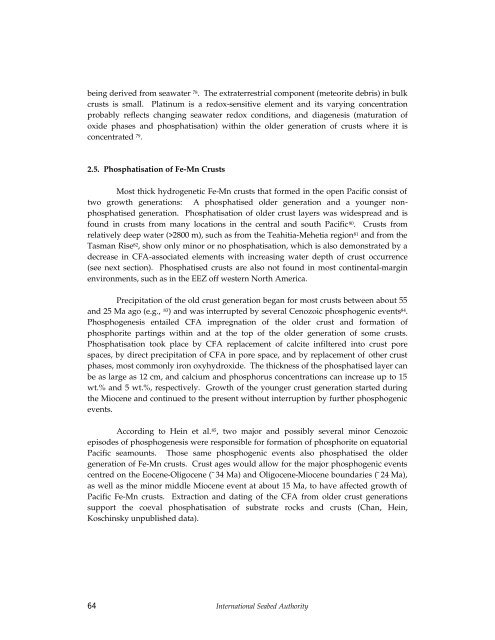Full page fax print - International Seabed Authority
Full page fax print - International Seabed Authority
Full page fax print - International Seabed Authority
Create successful ePaper yourself
Turn your PDF publications into a flip-book with our unique Google optimized e-Paper software.
eing derived from seawater 78. The extraterrestrial component (meteorite debris) in bulk<br />
crusts is small. Platinum is a redox-sensitive element and its varying concentration<br />
probably reflects changing seawater redox conditions, and diagenesis (maturation of<br />
oxide phases and phosphatisation) within the older generation of crusts where it is<br />
concentrated 79.<br />
2.5. Phosphatisation of Fe-Mn Crusts<br />
Most thick hydrogenetic Fe-Mn crusts that formed in the open Pacific consist of<br />
two growth generations: A phosphatised older generation and a younger nonphosphatised<br />
generation. Phosphatisation of older crust layers was widespread and is<br />
found in crusts from many locations in the central and south Pacific 80. Crusts from<br />
relatively deep water (>2800 m), such as from the Teahitia-Mehetia region 81 and from the<br />
Tasman Rise 82, show only minor or no phosphatisation, which is also demonstrated by a<br />
decrease in CFA-associated elements with increasing water depth of crust occurrence<br />
(see next section). Phosphatised crusts are also not found in most continental-margin<br />
environments, such as in the EEZ off western North America.<br />
Precipitation of the old crust generation began for most crusts between about 55<br />
and 25 Ma ago (e.g., 83) and was interrupted by several Cenozoic phosphogenic events 84.<br />
Phosphogenesis entailed CFA impregnation of the older crust and formation of<br />
phosphorite partings within and at the top of the older generation of some crusts.<br />
Phosphatisation took place by CFA replacement of calcite infiltered into crust pore<br />
spaces, by direct precipitation of CFA in pore space, and by replacement of other crust<br />
phases, most commonly iron oxyhydroxide. The thickness of the phosphatised layer can<br />
be as large as 12 cm, and calcium and phosphorus concentrations can increase up to 15<br />
wt.% and 5 wt.%, respectively. Growth of the younger crust generation started during<br />
the Miocene and continued to the present without interruption by further phosphogenic<br />
events.<br />
According to Hein et al. 85, two major and possibly several minor Cenozoic<br />
episodes of phosphogenesis were responsible for formation of phosphorite on equatorial<br />
Pacific seamounts. Those same phosphogenic events also phosphatised the older<br />
generation of Fe-Mn crusts. Crust ages would allow for the major phosphogenic events<br />
centred on the Eocene-Oligocene (˜34 Ma) and Oligocene-Miocene boundaries (˜24 Ma),<br />
as well as the minor middle Miocene event at about 15 Ma, to have affected growth of<br />
Pacific Fe-Mn crusts. Extraction and dating of the CFA from older crust generations<br />
support the coeval phosphatisation of substrate rocks and crusts (Chan, Hein,<br />
Koschinsky unpublished data).<br />
64 <strong>International</strong> <strong>Seabed</strong> <strong>Authority</strong>

















